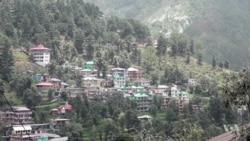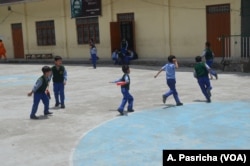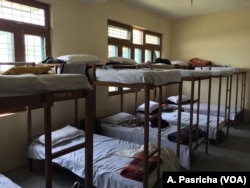The sprawling Tibetan Reception Center for refugees built ten years ago by Tibetan exile authorities in the northern Indian town of Dharamshala wears a desolate look. Its big dormitories with bunk beds were meant to house 500, but in recent years they lie mostly unused.
This facility was meant to be a transit stop for the over 2500 Tibetans who every year clandestinely crossed over high mountains from China into Nepal and then onto Dharamshala, the home of Tibetan spiritual leader, the Dalai Lama, since fleeing Tibet in 1959.
WATCH: Anjana Pasricha's video report
But the number of Tibetans coming to India has plummeted sharply over the last decade. In June, this center documented the arrival of only two young men in their early twenties who say they managed to cross over from Tibet.
Despite gentle persuasions by Tibetan officials at the center, they are still too scared to face the camera or share their names with this VOA reporter, but only say that they were Buddhist monks who have come to complete their monastic education, which they found difficult to do in Tibet. Fear and apprehension never leaves their faces during the 15 minutes they sit with us. “They are all fearful when they come,” says Karma Dolma, the deputy director of the Center.
Tibetan exiles attribute the plunging number of arrivals from Tibet to tighter surveillance, stricter border controls along mountain passes by the Chinese and more cooperation between Beijing and Nepal, whose relations have become friendlier in recent years.
Only 80 Tibetans came to India in 2017 and the number could be lower this year, according to officials of the Tibetan exile administration based in Dharamshala which represents the refugees. Its spokesman, Sonam Dagpo, attributes this to stricter policies by Beijing. “Now since 2008, China has brought very strict restriction in internal movement of Tibetan people. So now Tibetans cannot move freely in Tibet.”
The plunging numbers present a big challenge for second and third generation exiles in India campaigning for more political freedom for Tibetans, according to Tenzin Tselha, head of the Students for A Free Tibet in India. For Tibetans like her “a strong sense of imagination” about Tibet sustains their movements, but the “real perspective” brought by those who came from Tibet was always important.
“It is hard for us to get this sense of reality of what is happening inside Tibet because there are not many Tibetans coming,” says Tselha. “You talk to people from Tibet those who came ten years back, eight years back, five years back, but they are still further away from the reality because they are not not there right now.”
While the internet helps somewhat, the campaigners say it cannot compensate for first-hand accounts brought by newly-arrived Tibetan exiles about restrictions on movements, on Buddhist worship or a climate of fear inside the region had long given momentum to the Tibetan movement.
An ardent supporter of a freer Tibet, Gyaltsen, who crossed to India in 2004, also worries about the growing disconnect. “To connect with the Tibetans inside Tibet is really hard,” he says. “Only people who come from Tibet has the connections. Secondly people who come from Tibet they bring the culture things, not just their persons, they bring a lot of cultures, so it connects culture, people together. Once the people stop coming here, we are here but we [there] are no more any connections.”
The plunging refugee numbers means emptier infrastructure built by the exile community over six decades — there are fewer new entrants at Tibetan schools in Dharamshala, at Buddhist monasteries that dot the hillsides and at centers where they learn traditional arts such as Tibetan painting.
Even as the influx from Tibet stems, many young Tibetans in India are migrating for better opportunities. Among the many in Dharamshala who count friends who have left in recent times is Tselha from Students of a Free Tibet.
“I came six years back over here and now all my friends are gone. There is a mass migration that is happening now specially to the west, which I think the general assumption is [that it] is economic migration.”
Young Tibetans attending a workshop at a career counseling Center in Dharamshala say finding jobs in India is not easy. 23-year-old Lugya Dhondup crossed over in 2008 because he says his family thought he would get better opportunities to study in India. But he says “many of us don’t get appropriate job after school and since we don’t have anyone here to look after us, it is tough.” He would like to migrate if he can get a job overseas.
But while the numbers of young Tibetans in Dharamshala may be declining, the commitment to the cause of more freedom for Tibet remains unwavering in the home town of the Dalai Lama.










